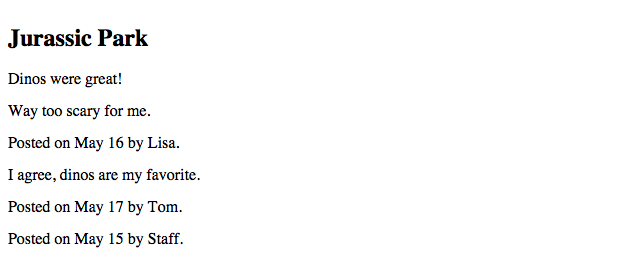HTML <article> 元素
HTML <article> 元素表示一个文档,页面,应用程序或站点中的独立结构,其意在成为独立的分发或可重用(例如,以联合方式)的结构。例如包括论坛帖子,杂志,报纸文章或博客条目。
使用 <article> 定义一篇文章:
<article>
<h1>Google Chrome</h1>
<p>Google Chrome 是 2008 年发布的免费开源网络浏览器。</p>
</article>
特性
| 内容类别 | 流式内容,章节内容,可触知内容。 |
|---|---|
| 允许的内容 | 流式内容。 |
| 标签省略 | 不允许,开始标签和结束标签都不能省略。 |
| 允许的父元素 | 任何接受流式内容的元素。注意 <article> 元素不能是 <address> 元素的后代。 |
| 允许的 ARIA 角色 |
application,document,feed,main,presentation,region
|
| DOM 接口 | HTMLElement |
属性
该元素只包含全局属性。
事件属性
<article> 标签支持 HTML 的事件属性。
使用注意
- 应该标识每个
<article>,通常将标题(<h1>-<h6>作为<article>元素的子节点。 - 当
<article>元素相互嵌套时,内部元素表示与外部元素相关的文章。例如,博客帖子评论的<article>元素可嵌套在代表博客文章的<article>元素中。 - 可以通过
<address>元素表示<article>元素的作者信息,但不适用于嵌套内层的<article>元素。 - 可以使用
<time>元素的datetime属性来描述<article>元素的发布日期和时间。注意,<time>的pubdate属性不再是 W3C HTML 5 标准的一部分。
实例
使用 <article> 定义一篇详细的文章:
<article class="film_review">
<header>
<h2>Jurassic Park</h2>
</header>
<section class="main_review">
<p>Dinos were great!</p>
</section>
<section class="user_reviews">
<article class="user_review">
<p>Way too scary for me.</p>
<footer>
<p>
Posted on
<time datetime="2015-05-16 19:00">May 16</time>
by Lisa.
</p>
</footer>
</article>
<article class="user_review">
<p>I agree, dinos are my favorite.</p>
<footer>
<p>
Posted on
<time datetime="2015-05-17 19:00">May 17</time>
by Tom.
</p>
</footer>
</article>
</section>
<footer>
<p>
Posted on
<time datetime="2015-05-15 19:00">May 15</time>
by Staff.
</p>
</footer>
</article>
规范
| 规范 | 状态 | 备注 |
|---|---|---|
HTML Living Standard<article> 的定义 |
现行的标准 | - |
HTML 5.1<article> 的定义 |
推荐 | - |
HTML5<article> 的定义 |
推荐 | - |
桌面浏览器兼容性
| 特性 | Chrome | Edge | Firefox | Internet Explorer | Opera | Safari |
|---|---|---|---|---|---|---|
| 基础支持 | 5 | 支持 | 4 | 9 | 11.1 | 4.1 |
移动浏览器兼容性
| 特性 | Android | Chrome for Android | Edge mobile | Firefox for Android | IE mobile | Opera Android | iOS Safari |
|---|---|---|---|---|---|---|---|
| 基础支持 | 支持 | 支持 | 支持 | 4 | 9 | 11 | 4.2 |

